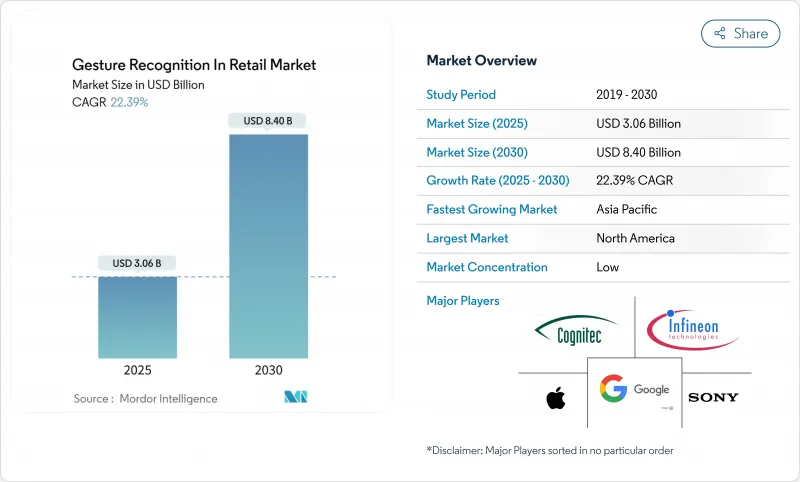
|
市場調査レポート
商品コード
1849961
小売業におけるジェスチャー認識:市場シェア分析、産業動向、統計、成長予測(2025年~2030年)Gesture Recognition In Retail - Market Share Analysis, Industry Trends & Statistics, Growth Forecasts (2025 - 2030) |
||||||
カスタマイズ可能
適宜更新あり
|
|||||||
| 小売業におけるジェスチャー認識:市場シェア分析、産業動向、統計、成長予測(2025年~2030年) |
|
出版日: 2025年06月23日
発行: Mordor Intelligence
ページ情報: 英文 140 Pages
納期: 2~3営業日
|
概要
小売業におけるジェスチャー認識市場規模は2025年に30億6,000万米ドルに達し、2030年には84億米ドルに上昇し、CAGR22.4%で進むと予測されています。

人手不足の深刻化、接触不要の移動に対する持続的な需要、エッジAIとミリ波レーダーの組み合わせにより、カメラが直接なくても棚越しのジェスチャー検知が可能になりました。小売企業はより豊富な通路内分析を得ることができ、消費者向けパッケージ商品ブランドはその結果得られる行動データストリームを収益化することができます。3DセンシングとAIチップセットが主流のPOS機器に統合されるにつれ、ハードウェアのコストは下がり続ける。主要市場における規制の明確化と、プライバシー保護アーキテクチャの成熟が、大規模展開のリスクをさらに軽減します。これらの力学を総合すると、小売業におけるジェスチャー認識市場は10年を通じて2桁成長を維持することができます。
世界の小売業におけるジェスチャー認識市場の動向と洞察
非接触型ショッピング体験への需要の高まり
パンデミック(世界的大流行)時代の行動様式は、タッチレス・ジャーニーに対する消費者の期待を確固たるものにし、欧州の大手食料品店は、フットプリント1,000 m2を超える本格的なコンピュータ・ビジョン・スーパーマーケットを検証しました。小売企業のレポートでは、平均レジ時間の短縮と顧客スループットの向上が測定可能であり、バスケットサイズの拡大とリピート来店につながっています。競合からのプレッシャーにより、中堅チェーンでさえ、ジェスチャーを使用したフロントエンドの再設計を評価するようになっています。プライバシーを保護するエッジアーキテクチャを導入する事業者が増えるにつれ、クラウド料金を追加することなく導入が加速します。こうした開発は、小売業におけるジェスチャー認識市場の短期的な成長見通しを強化します。
リテール機器における3DセンシングとAIチップの普及拡大
エッジシリコンは現在、リアルタイムのジェスチャー推論をローカルで実行し、帯域幅の制約を取り除き、待ち時間を削減しています。3D深度センサーと専用の機械学習コアを組み合わせた最近のプロトタイプでは、照明が変化する環境下でも、18のクラスで99.8%のジェスチャー精度を示しました。アジアのOEMは、大規模製造を活用して単価を20米ドル以下に押し下げ、地域の食料品店やコンビニエンスストアへの参入を可能にします。小売業におけるジェスチャー認識市場は、所有コストの低減と既存レーンの改造の容易さにより、その裾野を広げています。また、チップサプライヤーとソリューションインテグレーターによる共同リファレンスデザインは、社内のエンジニアリング人材が限られている小売業者にとって、統合の労力を軽減します。
ライブ店舗環境におけるアルゴリズムの複雑さと精度のばらつき
小売店の環境では、オクルージョン、反射面、群集の密度が発生するため、ラボの結果と比較すると、ジェスチャーの精度が低下します。コンピュータビジョンモデルでは、年齢層や体の可動性による偏りが依然として見られ、包含に関する懸念が提起されています。継続的な再トレーニングと、より大きなアノテーションデータセットは、導入コストを上昇させる。加盟店は、許容可能なパフォーマンスを維持するために、店舗ごとにセンサーのレイアウトを調整する必要があり、マルチフォーマット展開を複雑にしています。ミドルウェアプラットフォームがこのような複雑性を抽象化するまでは、一部のチェーンは慎重な姿勢を崩さず、小売業におけるジェスチャー認識市場の短期的な拡大を抑制します。
セグメント分析
タッチベースのプラットフォームは、2024年の小売業におけるジェスチャー認識市場シェアの78.1%を占める。しかし、衛生的でシームレスに統合されたストア・ジャーニーへのシフトを示すように、タッチレス・セグメントは2030年まで24.1%のCAGRで推移すると予測されています。出口のカメラ認識で会員を清算する大型クラブのパイロットは、タッチレスが手動のレシートチェックに取って代わることを示しています。ハードウェアベンダーは現在、RGB-Dカメラとともにレーダーセンサーを統合しており、材料費を削減し、かつてはタッチベースのパネルが好まれていた精度のギャップを埋めています。導入の信頼性が高まるにつれ、タッチレス製品に関連する小売業におけるジェスチャー認識の市場規模は2030年までに30億米ドルを超え、2024年の2倍になると予測されています。
特に高級ファッションや家電製品のショールームなど、利益率の高いセグメントでは、タッチレスジェスチャー認識はブランド体験を高める差別化要因であると小売業者が考えるようになっています。一方、タッチベースのプラットフォームは、サインキャプチャや受注生産のキオスク端末など、ピンポイントの精度が要求される使用事例には依然として適しています。こうした2つの経路は、完全な代替ではなく、共存モデルを示しており、サプライヤーは顧客のニーズに合わせて拡張できるモジュール式ソリューションを位置づけることができます。ニューラル・プロセッシング・ユニットの継続的な改良により、待ち時間は30ミリ秒以下に短縮され、直感的なインタラクションが維持され、小売業におけるジェスチャー認識市場へのさらなる浸透が期待されます。
手と指による入力が主流で、2024年の小売業におけるジェスチャー認識市場規模の66.8%を占める。しかし、フルボディシステムは、エッジボックスの高速GPUが骨格の動きをデコードし、没入型ディスプレイウォールや通路レベルの分析に利用されるため、2030年までのCAGRは23.4%となります。頭部を中心としたマイクロジェスチャーは、コンビニエンスストアやガソリンスタンドで早くから採用されています。音声とジェスチャーを組み合わせた調査プロトタイプは、意図の正確さにおいてより高いスコアを獲得しており、小売業におけるジェスチャー認識市場のマルチモーダルな軌道を示唆しています。
神経信号や筋肉信号を拾うウェアラブルバンドは、障害のある買い物客に新たなインタラクションレイヤーをもたらし、アクセシビリティを広げます。小売業者は、ホットスポットを特定し、通路を再設計するために全身ヒートマップを使用しており、ジェスチャーデータがフロントエンドのチェックアウトを超えた業務価値を解き放つことができることを示しています。使用事例が拡大していることは、高い計算能力が要求されるにもかかわらず、業界全体が高度なポーズ推定アルゴリズムへの投資を続けている理由を明確に示しています。
地域分析
北米は、2024年の小売業におけるジェスチャー認識市場規模の36.5%を占め、早期採用の大型チェーン店や比較的寛容なバイオメトリクス制度から恩恵を受けています。連邦政府のガイドラインは欧州よりも緩やかで、ROIが証明されると急速に規模を拡大するチェーン全体の試験運用を可能にしています。現在、500を超える食料品店がカメラのみによる出口チェックアウトを実施しており、この地域のリーダーシップを強化しています。
中国の決済エコシステムと日本の無人業態が、ジェスチャー認識をエンドツーエンドの店舗自動化に統合しているため、アジア太平洋は2030年までのCAGRが最も高い22.8%を記録します。政府による小売デジタル化補助金により、初期コストの障壁が低くなる一方、消費者はバイオメトリクス・プロセスを強く受け入れるようになります。現地でのハードウェア製造の密度が高まれば、サプライ・チェーンが短縮され、反復サイクルが加速されるため、さらに普及が促進されます。
欧州では、EUのAI法を満たすために、エッジ処理と暗号化クラウド同期を融合させたプライバシーに準拠したアーキテクチャが採用されています。多国籍食料品店がドイツ、フランス、北欧でジェスチャー対応のメガストアをテストし、EU全域での展開に向けた青写真を提供しています。ラテンアメリカと中東の新興地域は、小規模な基盤からスタートするが、グローバル・ベンダーが中規模スーパーマーケット・グループをターゲットにしたターンキー・パッケージを導入するため、2桁の導入が見込まれます。このようなカスケード効果により、小売業におけるジェスチャー認識市場は地理的に多様化しています。
その他の特典:
- エクセル形式の市場予測(ME)シート
- 3ヶ月間のアナリストサポート
よくあるご質問
目次
第1章 イントロダクション
- 調査の前提条件と市場の定義
- 調査範囲
第2章 調査手法
第3章 エグゼクティブサマリー
第4章 市場情勢
- 市場概要
- 市場促進要因
- 非接触型ショッピング体験の需要の高まり
- 小売機器における3DセンシングとAIチップの普及が進む
- スマートリテールと自律型店舗の形態の拡大
- 棚越しのジェスチャーを可能にするミリ波およびUWBレーダーの進歩
- CPGブランド向け通路内ジェスチャー分析の収益化
- オンラインと店舗での旅程を橋渡しするARスマートグラスの統合
- 市場抑制要因
- 実店舗環境におけるアルゴリズムの複雑さと精度のばらつき
- 継続的な視覚追跡に対するプライバシーと規制の反発
- エッジネットワークの遅延によりチェックアウト時にジェスチャが誤作動する
- 店舗内の密集したIoT導入による電磁干渉
- バリューチェーン分析
- 規制情勢
- テクノロジーの展望
- ポーターのファイブフォース分析
- 供給企業の交渉力
- 消費者の交渉力
- 新規参入業者の脅威
- 代替品の脅威
- 競争企業間の敵対関係
- 投資分析
- マクロ経済動向の市場への影響評価
第5章 市場規模と成長予測
- 技術別
- タッチベースのジェスチャー認識
- タッチレスジェスチャー認識
- インタラクションモード別
- 手と指のジェスチャー
- 頭/うなずきのジェスチャー
- 全身を使ったジェスチャー
- マルチモーダル(ジェスチャーと音声)
- 機能別
- 店内顧客エンゲージメントディスプレイ
- チェックアウト/販売時点管理と支払い
- 店舗運営、在庫、分析
- 小売業態別
- スーパーマーケットとハイパーマーケット
- コンビニエンスストア
- アパレル・百貨店
- 専門小売業者
- 地域
- 北米
- 米国
- カナダ
- メキシコ
- 欧州
- ドイツ
- 英国
- フランス
- イタリア
- スペイン
- その他欧州地域
- アジア太平洋地域
- 中国
- 日本
- インド
- 韓国
- オーストラリア
- その他アジア太平洋地域
- 南米
- ブラジル
- アルゼンチン
- その他南米
- 中東・アフリカ
- 中東
- サウジアラビア
- アラブ首長国連邦
- トルコ
- その他中東
- アフリカ
- 南アフリカ
- エジプト
- ナイジェリア
- その他アフリカ
- 北米
第6章 競合情勢
- 市場集中度
- 戦略的動向
- 市場シェア分析
- 企業プロファイル
- Apple Inc
- Google LLC
- Microsoft Corporation
- Intel Corporation
- Infineon Technologies AG
- Sony Group Corp
- Omron Corporation
- Cognitec Systems GmbH
- Crunchfish AB
- Elliptic Labs ASA
- GestureTek Inc
- Ultraleap Ltd
- Synaptics Incorporated
- Qualcomm Technologies Inc
- PointGrab Ltd
- Neonode Inc
- Cipia Vision Ltd
- Samsung Electronics Co Ltd
- Microchip Technology Inc
- STMicroelectronics N.V.


